Entrepreneurs, Nature and the Business Case for Sustainability


According to environmental ethics and philosophy, one of the sixteen principles of life is life tends to optimize rather than maximize. To “optimize” means to strike a balance between having or doing too much and having or doing too little. To “maximize” means not to balance an action or an outcome. It means to achieve the greatest gain without necessarily considering the costs, which could of course be negative. Or the costs could be positive, with the outcome being that there would not be balance or optimization. Environmental systems or ecosystems have multiple variables that interplay to produce tremendous biodiversity on this planet. Life in the natural world, when in balance, has a tendency toward optimization rather than maximization. This allows for flexibility and for adaptation of any one variable when the inevitable changes in an ecosystem occur.
Although humans are certainly a part of and a product of the natural world, we clearly can no longer be considered a “part” of nature since we do not generally desire optimization, but rather maximization. With our tools, our chemicals, our means of transportation, and especially our powers of reason and research, we have long become a force separate from nature in many respects.
As an entrepreneur and human interloper in the natural world, the five most important needs in my life are first - adequate sleep, silence, and stillness in the form of deep reflection or meditation. Second – the ability to move, specifically to run and then swim in water to refresh and cool my body while rinsing the dirt from the trail off my limbs. Third – being present in nature daily, or simply to be outdoors feeling the warmth of the sun, while sensing and appreciating the presence of a breeze. Fourth – being personally intellectually challenged through meaningful, productive work or study. Finally, to have a sense of balance, calmness, and inner stillness while the changes that are inevitable in life ebb and flow.
The time devoted to running and or swimming (until the lake cools in mid-October) is one to three hours every day. For merely attempting to be outdoors and not confined in a building, I devote between two and four hours every day. The sense of balance in life that comes in part from obtaining inner peace takes awareness and daily practice; time devoted to this is ongoing - hour by hour. As an entrepreneur striving to think creatively and to solve “sticky” problems related to human and ecosystem sustainability, I find that the time I spend in nature helps guide me in making the business case for sustainability for my company. Sustainability implies a balance between social, environmental, and economic imperatives; without constant exposure to natural environments I cannot imagine truly engaging with the possible outcomes and challenges inherent in entrepreneurship. All three components – people, planet, and profit – must be optimized to ensure sustainable growth through systematic feedback loops.
Being in nature, whether one is active or just sitting, has a way of illuminating the dichotomy and tensions between optimizing and maximizing business efforts. Goals may be set from a logical perspective yet being in nature softens the rhetoric while also preparing an initiative for maximum impact. It comes from welding nature’s optimization and human’s tendency to maximize. It is so pleasant to just “be” in nature. If I choose to just sit here, I can contemplate the value of this place. It is peace personified. It is itself without being outwardly demonstrative. Why am I just sitting? In the natural world, this world in which I now sit contemplatively, no goals are being set – or so it seems. Does the ant have a goal to dig a deeper burrow, to gather more grasses for its winter den? Does the coyote have a goal beyond finding the quickest, easiest route to the shore of the lake for a drink of water? Do the first small flocks of Canada geese that have just arrived this week for the winter have a goal? I spend most of my days here – in the water and running around the shoreline. I have immersed myself in it; in the cool hours of early morning and in the evening at sunset. I let this place be by itself during the heat of the day. At some point, rain will bring a refreshing take on the life that lives here. It seems we not only physically thirst, but thirst for renewal of the soul, of the heart. This renewal is here, in nature.
Some of the most important issues facing the world today include the following: First – from the standpoint of health and human mortality rates, access to adequate potable water and sanitation. Second – air and water pollution and the resulting imbalance in the utilization and productivity of resources worldwide, leading to poverty and destitution in some countries. Third – acts of genocide, war, and violence of all kinds; and finally – access to education at the most basic level for all human beings, which facilitates self-reliance and an intimate knowledge of man’s relation to our natural world and its, and our, finite existence.
These four challenges illustrate how intimately bound we as humans are to the natural world and to the planet that supports us. As the world’s population grows, and imbalances in wealth, health, and resources increase, two stresses will be evident: the impact on the world’s human population and the impact on the planet itself. Making the business case for sustainability in all that we do to mitigate and solve these challenges requires we learn to live in harmony with our planet and with each other. Physical, mental, and spiritual health on an individual level leads to inner peace and balance. Spending time in nature daily will promote that balance.
Image credit: Adam Kool/Unsplash
Renewables Offer New Opportunities to Inspire Consumers


A new Deloitte survey indicates that residential electricity customers are currently lagging behind in the clean power race. An information overload has left them waiting for guidance. This reality provides business stakeholders with an opportunity to take the lead and help customers, clients and the public at large accelerate the pace at which they adopt renewable energy.
Business stakeholders keep embracing renewables
U.S. businesses have jumped on the renewable energy train in rapidly growing numbers. Much of the acceleration has to do with basic bottom line considerations.
Wind and solar are competing with fossil fuels in a growing number of markets. In addition, evidence is mounting that renewable energy can help attract consumers and clients.
The ninth annual Deloitte Resources 2019 Study fleshes out this powerful trend. The survey includes the responses of more than 1,500 U.S. residential consumers and 600 businesses.
The study outlines a sharp contrast between residential and business customers. Residential customers care about climate change, but many are stuck in limbo. Meanwhile, businesses are “moving resolutely forward, becoming more sophisticated, achieving success, and upping the ante.”
“Businesses see opportunities to create new value by conserving resources, diversifying energy sources, procuring renewables, and deploying energy management systems and applications,” the study concludes. “Residential consumers are doing the best they can, but for many of them, the value proposition either isn’t there or isn’t clear.”
The consumer connection
The Deloitte survey makes a strong case for businesses to engage their customers on renewable energy.
The study finds that most businesses recognize the public relations value in transitioning to renewables:
“About two-thirds say their customers are demanding that they procure a certain percentage of their electricity from renewable resources, and a rising portion (72 percent) actively publicize their sourcing of renewables.”
The challenge is relating the business experience to the experience of individual electricity ratepayers.
Until recently, that gulf was a wide one. Renewable energy procurement was dominated by large corporations with a phalanx of consultants providing advice.
Now, as the Deloitte survey indicates, both the lessons that larger companies had learned, in addition to emerging best practices are providing smaller businesses with a smoother pathway for transitioning to renewable energy.
Deloitte notes that many businesses are practicing simple tactics that can be accessible to individual ratepayers. That includes participating in demand response programs and using sensors and timers on various equipment in order to become more energy efficient.
More businesses are also procuring on site renewable energy, mainly in the form of rooftop solar panels. As smaller companies climb onboard this trend, they help to demonstrate that renewable energy can scale down to individual property owners.
The rise of the millennial
In some areas, rooftop solar is already mainstream for consumers and businesses alike. However, state policies vary from one extreme to another across the U.S. Opportunities to work with a local utility also vary greatly from one service territory to another.
Making matters worse, the U.S. public continues to receive false and confusing messages about climate change and renewables from legislators and policy makers - starting from statehouses, to Congress and all the way up to the highest elected official under the U.S. constitution, the current president.
That provides business stakeholders with an opening to create clear, forceful messages about the state of climate science, and about effective pathways for taking action on climate change.
The question is where to begin.
For businesses that want to take the lead, the survey suggests at least one effective pathway for progress: the millennial generation.
The Pew Research Center identifies millennials as those born between 1981 and 1996 - or those persons currently aged 23 to 38.
That age grouping connects the millennial generation with the traditional 18-34 age group coveted by advertisers. It’s also a group that is more receptive to mobile marketing.
While many electricity consumers continue to suffer from a sort of renewable energy malaise, the Deloitte survey finds a bright spot among the millennial participants in the survey.
Millennials “consistently rate clean energy and technology options higher than other age cohorts,” the survey finds, and they are “more receptive to messaging about new products and services, more willing to try them out, and even potentially to pay more for cleaner energy sources if necessary.”
Renewable energy: now what?
For businesses that are determined to spread the renewable energy message, some advice can be gleaned from Deloitte’s guidance to utilities and other energy suppliers.
For electricity providers, Deloitte advises a renewed focus on “engaging and communicating effectively” with millennial electricity customers, as well as identifying millennial concerns that are also common to other generations.
Similarly, business can help provide clarity on renewable energy by publicizing how their own resource management strategies are helping to reduce carbon pollution. That message already resonates strongly with millennials and it can also ripple out to have an impact on other generations.
Clarity on climate change
Business stakeholders have already stepped up to advocate for renewable energy, but the Deloitte survey provides evidence that they can do more.
Businesses can leverage their advertising dollars and their political clout to push back against false messages about climate change and renewable energy.
U.S. businesses have already staked out ground on issues of broad social concern including gun control, LGBTQ equality and immigrant rights and, most recently, abortion rights.
In recent years, they have also been calling on social media and high profile television personalities to account for hate speech and other offensive behavior.
In another significant development, just last week a group of 600 U.S. businesses publicly challenged President Trump on his tariff policy.
The time is right for businesses to lead on renewable energy and climate change, too.
Ulrike Leone/Pixabay
Companies Are Turning AI Risks into Opportunities


Critics of artificial intelligence (AI) have found their fair share of reasons to raise concerns about this technology. Facial recognition systems that don’t recognize darker-skinned faces. Hiring algorithms that bypass resumes that contain the word “women.” A chatbot taught through interactions with users to be racist and misogynistic. But these examples don’t have to define the future.
AI systems are only as good as the data put into them, including implicit racial, gender or ideological biases. As more and more examples of AI gone wrong arise, the risks are threatening to overshadow AI’s potential benefits. And with each new example, the public’s trust in AI further erodes.
A growing number of companies are taking note and action to mitigate the risk and, in the process, finding opportunities to offer solutions.
Serving up responsible solutions for AI
After becoming one of the founding members of the Partnership for Responsible AI, tech giant IBM is creating methodologies that will enable its clients to detect and mitigate bias within their AI applications. The company is also sharing its knowledge through the Fairness 360 Open Source Toolkit, which helps app developers examine, report and mitigate discrimination and bias in machine learning models throughout the AI application lifecycle. This program includes more than 70 fairness metrics and 10 bias mitigation algorithms with relevance to finance, human capital management, healthcare and education. It also contains three tutorials that detect and mitigate age bias in credit scoring, racial bias in medical management, and gender bias in face images.
Microsoft is building a tool to identify bias in a range of different AI algorithms and to raise awareness among its employees.
“The most important thing companies can do right now is educate their workforce so that they’re aware of the myriad ways in which bias can arise and manifest itself and create tools to make models easier to understand and bias easier to detect,” Rich Caruna, a senior Microsoft researcher told the MIT Technology Review last year.
Google has introduced a Google Crash Course: Intro to Fairness module that teaches developers about top fairness considerations when building, evaluating and deploying machine learning models.
Jigsaw, a unit within Google's parent company Alphabet, recently announced a partnership with GLAAD to create public data sets and machine learning research resources to help make online conversations more inclusive of the LGBTQ community.
“Our mission is help communities have great conversations at scale,” said Cj Adams, Jigsaw Product Manager. “We can't be content to let computers adopt negative biases from the abuse and harassment targeted groups face online.”
It’s not just tech firms who have been proactive on the AI front. Accenture is also getting on board through its new Applied Intelligence practice, which recently launched the “AI Fairness Tool.” The tool examines data influence of sensitive variables (age, gender, race, etc.) on other variables in a model, measuring how much of a correlation the variables have with each other to see whether they are skewing the model and its outcomes. It then helps correct the bias in the algorithm.
Accenture is currently fielding partners for testing the tool, which it has prototyped so far on a model for credit risk, and is preparing for a soft launch. The tool will be part of a larger program called AI Launchpad, which will help companies create frameworks for accountability and train employees in ethics, so they know what to think about and what questions to ask.
“I’m hoping that this is something we can make accessible and available and easy to use for non-tech companies – for some of our Fortune 500 clients who are looking to expand their use of AI, but they’re very aware and very concerned about unintended consequences,” says Rumman Chowdhury, Accenture’s global responsible AI lead.
No single person has the context to spot everything
Michael Li, founder and CEO of The Data Incubator, a data science training and placement firm, told the Harvard Business Review he believes that “the risks of AI can come from any aspect of business, and no single manager has the context to spot everything. Rather, in a world in which AI is permeating everything, companies need to train all their business leaders on AI’s potential and risks, so that every line of business can spot opportunities and flag concerns.”
He calls on business to offer its employees specialized AI training to understand both the possibilities and the risks. “This is not technical — executives don’t need to be hands-on practitioners — but they do need to understand data science and AI enough to manage AI products and services. Business leaders need to understand the potential for AI to transform business for the better, as well as its potential shortcomings — and dangers.”
Image credit: Gerd Altmann from Pixabay
If You Missed the World Circular Economy Forum 2019 — the Elephant is Still in the Room


"The World Circular Economy Forum brought together more than 2,000 business leaders, policymakers and experts from around the world to present the best circular economy solutions," it states on its website. As such, it reflects the current state of affairs and the direction of the international community towards transitioning to a circular economy. There’s really no better place to be if you crave a rich multi-stakeholder perspective on the topic in the short span of two days.
The Forums’ key messages were "scale it up," "make it fair and inclusive," and "EU lead the way." There were other messages, which we’ve tipped toed around, but that present the leverage points and recommendations that could actually get us moving and help scale up the transition.
Internalize externalities
Crossing through all discussions was recognition that the “old system is bust." This is because it simply doesn’t take into account the environmental costs or externalities that are inherent to everything we produce and consume. It is profitable for companies to sell twelve suits instead of the two that we really need, or to design products for obsolescence. There are still plenty of financial incentives and subsidies that artificially reduce the price of virgin resources leading to their overuse and making recirculation of secondary materials very difficult to achieve. The moment we start setting up cost structures that recognize the value of natural capital, such as taxing things we want less of (e.g., waste and emissions), subsidizing those that we want more of, leveraging public procurement, and being bold on pricing, our production systems will start to change.
Redefine our approach to value creation
It seems that the most difficult conversation to spin off centered on redefining value. At the moment, value is created through resources extraction and depletion, the success of which is measured through GDP. However, if one were to measure social well-being, that would throw us to the other side of the pendulum. As Janez Potočnik from the International Resource Panel said, “nobody likes the discussion about sufficiency because it’s uncomfortable." But in the world of increasing consumption, resource efficiency is simply not going to contain us within the planetary boundaries.
A circular economy is one where we use fewer non-renewable resources and carefully manage renewable resources. In other words, it is one in which we align our actions and intentions with the commitments we’ve made for sustainable development when we adopted Agenda 21 way back in 1992 in Rio de Janeiro. Since then, we’ve not moved away from growth to prosperity, and are avoiding the conversation. As Jocelyn Blériot from the Ellen MacArthur Foundation put it, “circular economy principles cannot just be slotted in the current economy — we’re not really making progress where the bulk of consumption is happening, that’s why we need to touch the boundary conditions and open the discussion on the fundamentals”.
That will require a massive collaboration and co-creation effort, bringing key stakeholders and decision makers around one table in a truly multi-stakeholder dialogue, thinking of the world we want to live in and understanding what stands in the way of achieving it, and setting up standards, metrics, and guidelines that will guide us in the right direction of the transition, fair and inclusive, and help us track progress.
End our obsession with deregulation
Another difficult one. As Stientje van Veldhoven, the Minister of the Environment in the Netherlands, said it in her opening speech, “no government is going to prohibit its citizens from fulfilling their material needs and wishes if they have the means to." In other words, political decisions sometimes make for difficult transitions. However, hard as it is to confront, but with current 2.7 Earths consumption patterns, we need some consumption floors and ceilings. If we are to scale things up, business needs clear and predictable policy that creates a level playing field for all — and that’s the role of public officers.
At the same, for most countries that are yet to consume and enroll in the lifestyles and affluence we are lavished with in the developed world, strong policy presents an opportunity to design good regenerative systems from the beginning, instead of coming back at the problem once it’s been created.
Find a unicorn to shift the consumer behavior
Consumer is king. But he also often doesn’t know what’s good or bad for the environment, or has the means/wish to change his behavior. How do you move the tectonic plate that is the consumer demand for business to have the reason to change the way it satisfies this demand? Indeed, somebody forcing a limit on how much and what things I can enjoy is difficult, but raising my awareness is easier.
Peter Bakker, from the World Business Council for Sustainable Development, gave great examples why plastic and food waste have become catalyzers for action at an unprecedented level before — “we feel guilty seeing photos of whales choked on plastic or food waste!” Through these examples we see direct consequences of our daily routine actions and behaviors. Finding smart and specific examples like these for each sector — travel, construction, entertainment, etc. — and raising awareness and giving the media coverage they deserve, could move the needle on consumer behavior.
We are in a global emergency, with time really running out. But as Janez Potočnik said, “we are still on the right side of history — it gives a lot of energy."
Previously posted on the GRI blog and the 3BL Media newsroom.
Image credit: Lacey Williams/Unsplash
Points of Light Announces The Civic 50 for 2019


For almost 30 years, Points of Light has been mobilizing volunteers to the point of what the Atlanta-based nonprofit says now has a reach of 250 cities across 37 nations worldwide.
One way in which this nonprofit seeks to motivate more organizations to boost their citizenship efforts is through its annual Civic 50 awards. These awardees together offer a template for how forward-thinking companies can move community engagement and social impact as focal points of their business.
“Points of Light believes that companies, their employees and partners can be drivers of transformative social change in communities around the world," said Natalye Paquin, president and CEO of Points of Light. “This year’s honorees of The Civic 50 collectively gave $2.3 billion to their communities—often giving 50 percent more than other companies—and volunteered for more than 10.5 million hours in 2019. These results exemplify exceptional corporate leadership in community and civic engagement.”
The Civic 50 honorees are both public and privately-held companies with U.S. operations that have revenues of at least $1 billion. Those companies that make this list are chosen based on four pillars, or should we say, the four “I’s”: investment, integration, institutionalization and impact.
First launched in 2011, these awards offer a standard for corporate citizenship and give organizations ideas on how companies can harness their employees’ time and expertise to improve the quality of life within the communities in which they conduct business.
This year’s Civic 50 reads like an A-to-Z list of leading companies and spans just about every major industry. Companies on this year’s list include Aflac, CVS Health, Deloitte, Delta Air Lines, General Mills, Hewlett Packard Enterprise, Marriott and Symantec. Within the materials sector, Freeport-McMoran leads the pack, according to Points of Light. And when it comes to having a top volunteer culture, General Mills comes out on top this year.
According to Points of Light, there are several ways in which these 50 companies stand out—in terms of their level of community involvement, as well as how intensively they measure their programs’ impact:
Generous giving: On average, the Civic 50 companies have donated more than twice as much when compared to other U.S. companies: $283,000 for every $10 million in revenue earned as opposed to $130,000.
Increasingly sophisticated giving: Almost half of the Civic 50 companies make “multi-faceted investments,” i.e., their grants come with additional support via volunteerism, in-kind goods or services, or multi-year pledges.
Business function integration: Community involvement programs are becoming increasingly integrated with these companies’ functions. The business functions most commonly supported with community involvement are employee engagement (98 percent), marketing or communications (94 percent), and diversity and inclusion programs (90 percent).
Board-level involvement: A large majority (86 percent) of the Civic 50 companies include community involvement in the agenda of at least one of these companies’ board meetings annually.
Social impact and measurement: Two-thirds of the Civic 50 companies gauge the results and social impact of their grants as part of regularly monitored data collection process.
Image credit: Joey Kyber/Unsplash
Pollinator Habitats Are Declining Worldwide, But Business Can Help


This article series is sponsored by General Mills and produced by the TriplePundit editorial team.
Bees are necessary to pollinate plants, including crops we use for food, but bee populations are in decline worldwide. For well over a decade, colony collapse disorder (CCD) has shaken the agricultural sector and challenged scientists. This mysterious phenomenon occurs when the majority of adult worker bees in a colony disappear, leaving the queen behind.
Though reports of CCD have declined in recent years, it’s far from the only threat facing bees. Exposure to pesticides, as well as parasites, pests and pathogens, continue to threaten the health of bee populations, according to the U.S. Department of Agriculture (USDA). Bees and other insects are also increasingly vulnerable to habitat loss and weather fluctuations associated with climate change.
Co-director of the pollinator program for the Xerces Society, Eric Lee-Mader is the go-to guy for bees. Based in Portland, Oregon, the Xerces Society is among several groups spearheading the effort to protect pollinator habitats and stabilize bee populations worldwide.
Their hard work is paying off: “We have more research [and] more concrete science than we've had before,” Mader told 3p. “For a long time, pollinator declines were partially documented, partially speculative. And we're now entering the timeframe where they're more documented and less speculative.”
That’s the good news. With more research and better science, the picture comes into stark focus. “Consistently across the board, what we see is that the declines are real,” Mader told us. “In some cases, the declines are really catastrophic.”
TriplePundit last spoke with Mader back in 2017. We recently caught up with him for an update on the science, conservation, and management of pollinators and their habitats. “The situation is not improving, and arguably it's deeper and more entrenched and getting worse than we have previously thought,” he explained. “I think we arrive at kind of a holistic picture of what's going on with pollinators by looking at this whole spectrum of different studies that are out there now being published.”
Among the recent research, a paper published in the journal Biological Conservation earlier this year found that more than 40 percent of insect species globally are threatened with extinction within “the next few decades.” Similarly, the landmark “insect Armageddon” study published in 2017 warned of a 75 percent loss of insect biomass since the 1980s.
Among many of the drivers pushing pollinators to the brink, like climate change and the pervasive use of chemical pesticides, is habitat loss from intensive agricultural land conversion.
“Conservatively speaking, just in agricultural lands, there’s probably been a 20 million-acre loss of habitat over the past decade,” Mader says. Countering that trend is approximately 700,000 acres of land restoration for pollinator habitat, according to best estimates.
There is no candy-coating the situation. Clearly, we humans must do more to address the precipitous decline of bees and other at-risk insects.
What business can do to save the bees
An important part of Mader’s work is collaborating with businesses and their agricultural supply chains. The Xerces Society works with food and agriculture companies like General Mills in a multi-pronged approach aimed at consumer awareness, habitat conservation and on-the-ground guidance for improving agricultural practices.
When we spoke with Mader, he had just returned from a trip to California on behalf of General Mills. The Xerces Society’s collaboration with the company began about seven years ago with some pilot projects to help restore pollinator habitat on tomato and almond fields in California’s Central Valley.
Based on these initial projects, Xerces developed “very high-quality, compelling case studies and demonstration of how we can incorporate habitat at scale back into [a company’s] supplier farms,” Mader told us. Farmers working with Xerces added miles of hedgerows, native perennial wildflower strips and cover crops, where before the Valley's vast almond orchards were “like moonscapes below the trees,” Mader said.
“We really flipped that model around and worked with [farmers] to formulate and develop feed mixes that can provide flowers and habitat in the orchard itself and can be mowed down before the harvest happens,” he told us. “It's completely compatible with their management system.”
These new plantings provide vital habitat for pollinators and other insects, allowing both agricultural land and natural ecosystems to co-exist together. The success of these early models motivated General Mills to come back to Xerces to scale up these methods to a “significantly larger portion of their supply chain,” Mader explained.
The landscape is changing
Against the backdrop of the somber story of pollinators, the landscape is changing—literally. “Collectively, we're putting in miles of hedgerows every year; we're putting in acres and acres and acres of flowering habitats and flowering cover crops on farms,” Mader said. “Just through that supply chain work ... we are easily impacting tens of thousands of acres of farmland and creating conditions that are significantly more amenable to pollinators.”
Efforts like these make an impact, but Mader stresses that the food and agricultural sector needs more participants like General Mills that are truly committed to take the problem seriously.
This is the real message here: Key partnerships between science, research and business have proven solutions. What we need now is for the food industry to step up, at scale, and implement these solutions.
Otherwise, the cupboard is bare, as demonstrated by this pop-up installation in Toronto. In 2017, General Mills' Honey Nut Cheerio's team in Canada opened a temporary “Grocery Store of the Future,” which shows what our food supply would look like with and without bees.
Here's a typical grocery store:

And here's what those same shelves would look like if we fail to protect bee populations:
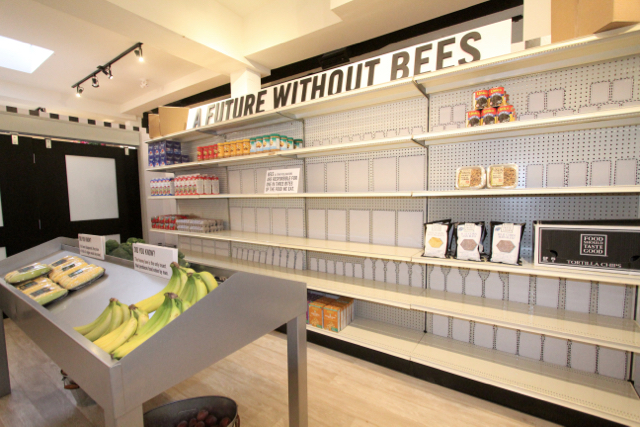
As is often said, a picture is worth a thousand words.
Image credits: Eric Ward, Aaron Burden and General Mills
Lingrove’s ‘Fake Wood’ Is One Answer to Deforestation


In spite of efforts by organizations like the Forest Stewardship Council (FSC) to increase sustainably harvested wood, deforestation continues to be a major problem worldwide, and it is getting worse. Annually, development, from farms to building tracts, has resulted in the destruction of more than 32 million acres of forests.
This loss of forests contributes significantly to climate change: the FSC says deforestation causes 20 percent of total greenhouse gas emissions--let alone damaging lands in which wildlife and people that rely on forests live.
Drastic action must be taken and the XPRIZE’s Future of Forests Impact Roadmap identifies 10 breakthroughs needed to slow or stop the destruction. First is “super-wood,' defined as a “sustainably-produced alternative for wood” that has similar properties, thus shifting the reliance on virgin wood away from natural forests.
Barking up the right tree
Lingrove, a start-up in San Francisco, is well on its way to achieving this breakthrough with its product called Ekoa. The biomaterial was originally developed for Blackbird Guitars as a tonewood (wood most suitable for acoustic instruments) replacer and its name is derived from koa, an exotic Hawaiian wood used for ukuleles and guitars. In 2014, Blackbird Guitar's Clara ukulele won JEC's Composite Innovation Award. Its Savoy guitar also received a very positive review from a music publication in 2018 - so clearly, Lingrove’s product can compete on both durability and quality.
Ekoa combines Canada-grown flax (linen) fiber with a cashew-based bioresin. Flax is a fast growing and hardy grass-like plant that can survive drought and poor soil conditions. The flax fibers help provide the natural grain look of the product. More importantly, the fibers are considered carbon-negative because they sequester carbon during the growth cycle, which isn’t released during processing of the composite material.
Third-party testing results that Lingrove has disclosed make the point that Ekoa could perform even better than wood and other competing materials as follows:
-
Three times the vibration damping of glass
-
30 percent lighter than carbon fiber
-
Stiffer than aerospace-grade fiberglass
-
Stable over a wide temperature range
-
Flame and humidity resistant
Its cost, according to Lingrove, is much lower than premium wood and similar to aerospace-grade fiberglass.
Conventional processing combined with sustainability
Flax fibers are combined with resins in a continuous process. Conventional composites processing methods are used including vacuum bagging, compression molding, wet layup, autoclave and bladder molding. Specifications such as color, moisture, ultraviolet and fire resistance can be designed into the raw fibers or resin before the composites process. Specialty backings can also be introduced during this process to add thickness or other functional benefits, such as acoustic performance. The finished material is available as rollstock.
In late 2017, Lingrove launched Ekoa TP, which uses a lignin-based thermoplastic for industrial-scale fast processing and recyclability. The look and feel of wood is still obtained but with much better sustainability. After the product is cut and layered in a mold, it’s easily compression molded into three-dimensional composite shapes for interior and furniture applications.
Ekoa is now being produced at a continuous sheet production capacity of 2,500 feet per day, with a goal to scale up to 5,000 feet per day. In the future, Lingrove is looking at incorporating more agricultural waste, more bio-plastics and more post-industrial, post-consumer recycled resins in its formulation.
Besides Blackbird Guitar, Steelcase is a major customer. Lingrove also has projects underway with large companies in interiors, transportation, sports and some consumer electronics. Some products applicable to the construction market include moldable veneers for furniture and surfaces, and structural panels.
Although Lingrove claims it has no direct competitors, it does compete with the same applications made from high-energy consuming materials such as fiberglass, carbon fiber, polyvinyl chloride and vinyl, reconstituted wood and even some metals.
Not out of the deforestation woods yet
Despite no direct competitors, Lingrove still has marketing challenges to overcome. “Disrupting the materials landscape is easier said than done,” says Elaine Chow, a co-founder of the company and Lingrove’s director of business development. “There are a lot of rules and regulations around what materials can be used and where.”
She also explains the many reasons why bio-based and upcycled materials have been slow to gain traction. These factors include higher cost, smaller scale, lower performance and a less desirable aesthetic. “At Lingrove, we want to reframe what bio-based and recycled materials look, feel and work like,” says Chow. “We believe Ekoa sits at the intersection of ecology, desirability, scale and high performance.”
Image credit: Lingrove
The Apparel Sector Is Getting It: Better Cotton Now Accounts for One-Fifth of Global Production
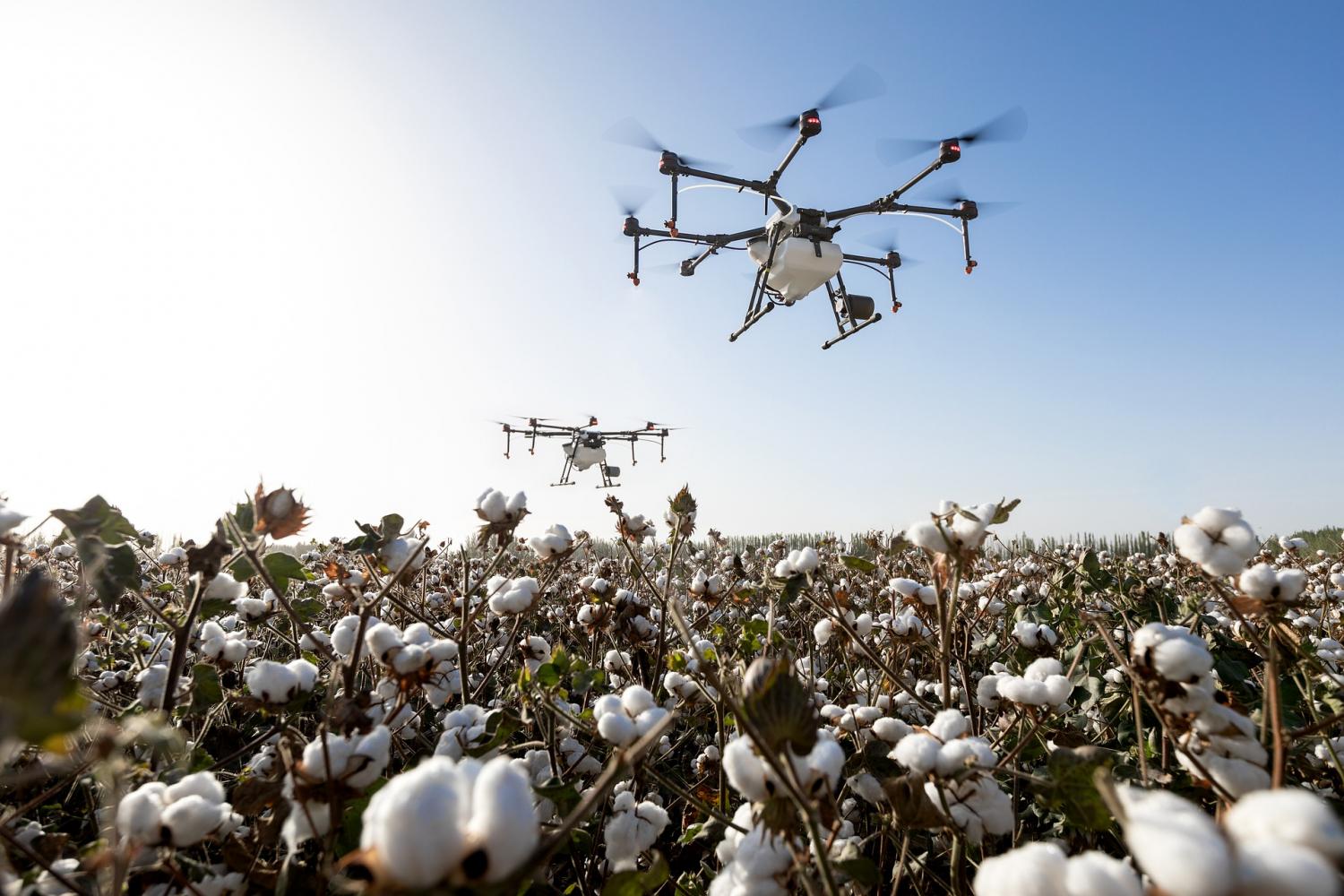
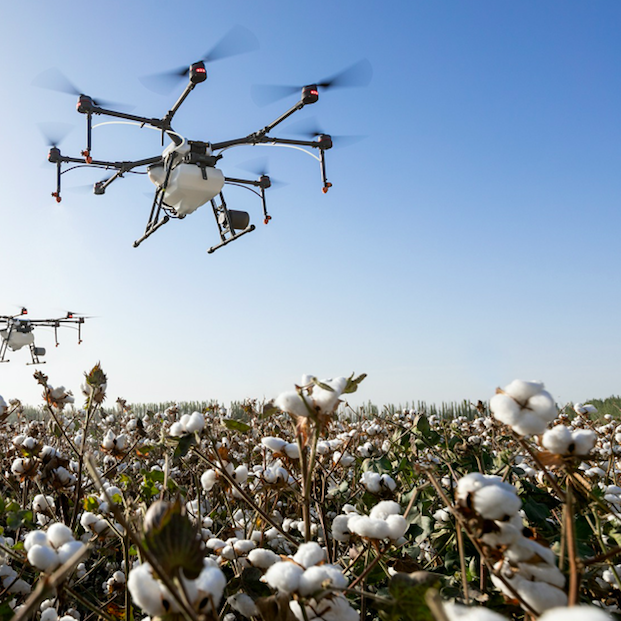
The cotton industry – long criticized for its adverse environmental, social and labor impacts – is rapidly undergoing a transformation led by the nonprofit Better Cotton Initiative (BCI). In its just released 2018 annual report, BCI’s figures show that the amount of ethically and sustainably produced “Better Cotton” is growing fast. It accounted for 19 percent of global cotton production during the 2017-18 growing season, with an astounding 2 million farmers now licensed to produce Better Cotton by BCI; and 99 percent of these farmers are smallholders farming on less than 20 hectares of land.
“BCI’s Retailer and Brand Members passed an important milestone at the end of 2018, sourcing more than one million metric tonnes of ‘Better Cotton’,” said Alan McClay, BCI’s chief executive officer, to TriplePundit. “This demonstrates that multiple stakeholders, working together, can shift a global system so that sustainability becomes the mainstream.”
One million metric tonnes is an astounding 75 percent increase from 2016-17, and it did not happen by accident. The training and certifying of farmers is a process that requires extensive field work, and BCI has operations with implementing partners in 21 countries, including key cotton producers India, Pakistan, South Africa and the United States.
Increasing the supply of sustainable cotton is important as there are several problems with conventionally grown cotton. First, there’s water – cotton has a reputation for being “difficult,” water-wise. Numerous non-profits and global media outlets such as the Guardian have laid blame on cotton for dwindling water resources in places like India, or for the environmental devastation of the Aral Sea in Central Asia. Then there’s the fact that cotton uses large amounts of pesticides, which results in serious water pollution issues in regions like the southern United States.
At the same time, there are not necessarily any viable replacements for cotton. The main alternatives – synthetic materials such as polyester and nylon, plant-based rayon, or leather – are rife with their own sustainability challenges as well. Considering the growing concern about polyester-based microfibers in the ocean, some of these concerns are, arguably, creating problems that in the long term could be create potentially worse. Moreover, none of these alternatives can, currently, replace the scale of cotton, which still accounts for 40 percent of all raw materials used in textile production globally. Furthermore, cotton is durable, recyclable and provides livelihoods to millions. Quite simply, cotton is an essential part of the global economy, and that is not changing anytime soon.
BCI’s solution is to make cotton better, both for the environment, and for those who depend on it for their livelihoods. BCI defines “Better Cotton” as cotton grown following seven principles. These include environmental factors – crop protection, water stewardship, soil health, land, and biodiversity, but also, importantly, social factors too, including decent working conditions and fair compensation. The ultimate goal, according to BCI, is to allow farmers to produce cotton that measurably better for the environment and farming communities.
Two million farmers comprise a huge number, but this is just the start. BCI says it has a goal to certify five million farmers by 2020, when it also aims to have 30 percent of all global cotton being grown following its standards. By then, it may be able to achieve what many have believed was impossible – systematic, supply-chain wide change.
“We are approaching a tipping point. As more [members] source ‘Better Cotton’, we will be able to reach and support more cotton farmers, building momentum on our ambition to transform the sector, reduce its environmental impact and strengthen farmers’ ability to improve their livelihoods,” said McClay.
Increasing demand is key, as Better Cotton needs buyers to remain viable. So far, the demand if there, as brands including Hennes & Mauritz, IKEA, Gap, Adidas and Nike all sourced record levels of Better Cotton last year. Together, more demand and greater supply can, hopefully create a virtuous cycle – and provide a model for how to achieve rapid, scalable and meaningful progress on a complex global supply chain.
Image credit: DJI-Agras/Pixabay
The Three-Ring Circus Marking Today's Recycling Industry
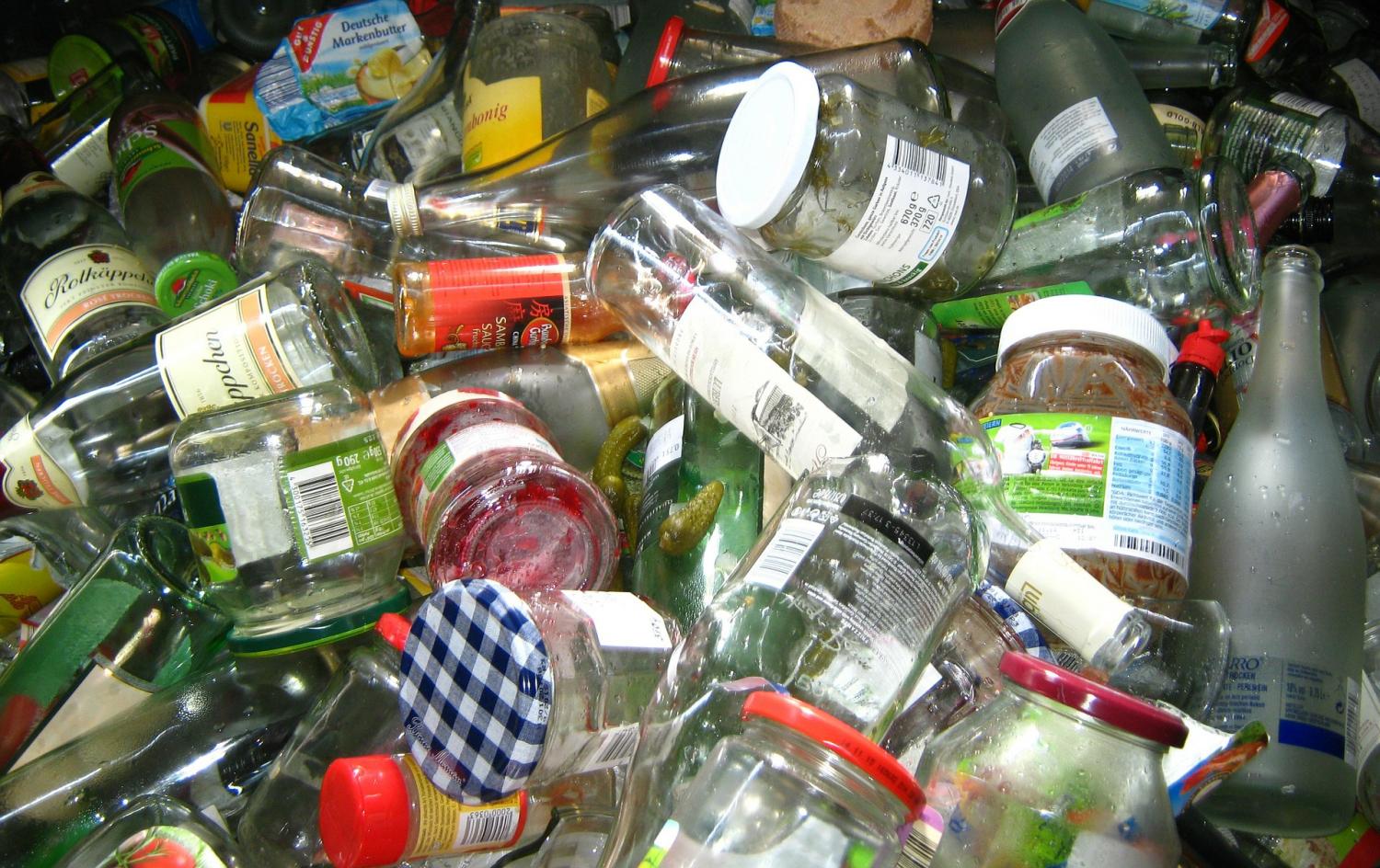
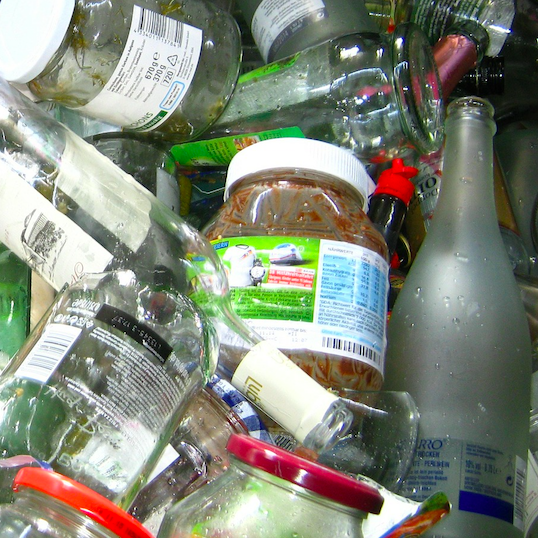
Since the recycling crisis began in 2018, there has been a steady drumbeat of media coverage on the topic of recycling. What most people do not understand is the “recycling crisis” is made up of several issues: evolving economics around recycling, a lack of consumer understanding on what is and isn’t recyclable and confusion over the issue of plastics.
The multiple storylines being played out in the news media on recycling have led to mixed messages and inaccuracies, with different issues taking the spotlight at different times. Here is a look at the separate issues that are playing out in the three-ring circus of today’s recycling industry:
Ring #1 – The Business and Economic Model is Broken
Consumers simply do not understand the true costs associated with recycling. For decades, the actual costs have been subsidized by the value of the recyclable commodity sold at market. That means companies collecting recyclables have been charging the resident a price that does NOT fully cover the cost of service because that difference could be made up in the marketplace.
Furthermore, over the past 18 months, China exited the global commodity market, leaving at least 40 percent of the world’s volume of recyclables seeking a home. This has led to a massive over-supply in alternate global markets and a dramatic drop in the value of recyclables – meaning that companies providing this service are no longer able to make up the difference between the low price of service and the value of the commodity. Given that this reality is unlikely to change anytime soon, action needs to be taken. This requires an immediate reset of contracts and economics to ensure that recycling programs continue in America.
Ring #2 – Contamination is a Big Issue
Because of trends in packaging over the past 10+ years and a general lack of public education, America does not know what to recycle, or how to recycle properly. In some cities, this results in 30 percent or more contamination. Contamination is the inclusion of non-recyclable material in the recycling stream, which drives additional costs to separate the garbage out of the recycling stream and dispose of it properly.
Through public education campaigns like Recycling Simplified, we can all become better at recycling the items that are truly beneficial to the planet. This site is available to all consumers - not just Republic customers - and has tips for what and how to recycle. However, achieving zero contamination levels will NOT fix the Business and Economic crisis in Ring #1 above.
Ring #3 – Plastic, Plastic, Plastic
Every day brings another article about plastics and the impacts on the planet from improper processing or disposal of the material. As a result of the economic headwinds in Ring #1 above, many forms of plastic (namely #3-7) are becoming unmarketable, rendering them part of the contamination issue in Ring #2. The combination of a lack of consumer understanding of how to recycle with the changes in what can be captured and sold on the global market is intensifying the narrative of plastic pollution in our rivers and oceans. Plastic in the environment is not a recycling issue, it’s a litter issue. In the larger recycling tent, plastics really are a sideshow. We must address the challenges in Ring #1 and Ring #2.
Do not be confused by the juggling storylines. Each on its own is important, but the single most important topic in the recycling industry is the need to ensure the programs and underlying contracts are set up to be durable and viable. Without them, we’re trapeze artists operating without a net. A community aspiring to pivot toward “zero waste” cannot have the collection and processing of their recycling programs subsidized by the unpredictable future value of materials.
Recycling needs to stand on its own. The reality is this: If contracts were set up properly today, there would be no crisis. Instead we would have a viable and thriving market that would allow for the successful collection and recycling of materials in our country. We’d all simply be focused on optimizing the programs, through public education (to reduce contamination), and evaluation of what should be in the materials list (re-evaluating items such as some forms of plastics and glass).
Image credit: Gerd Altmann/Pixabay
Abortion Is Now a Part of the Corporate Activism Conversation
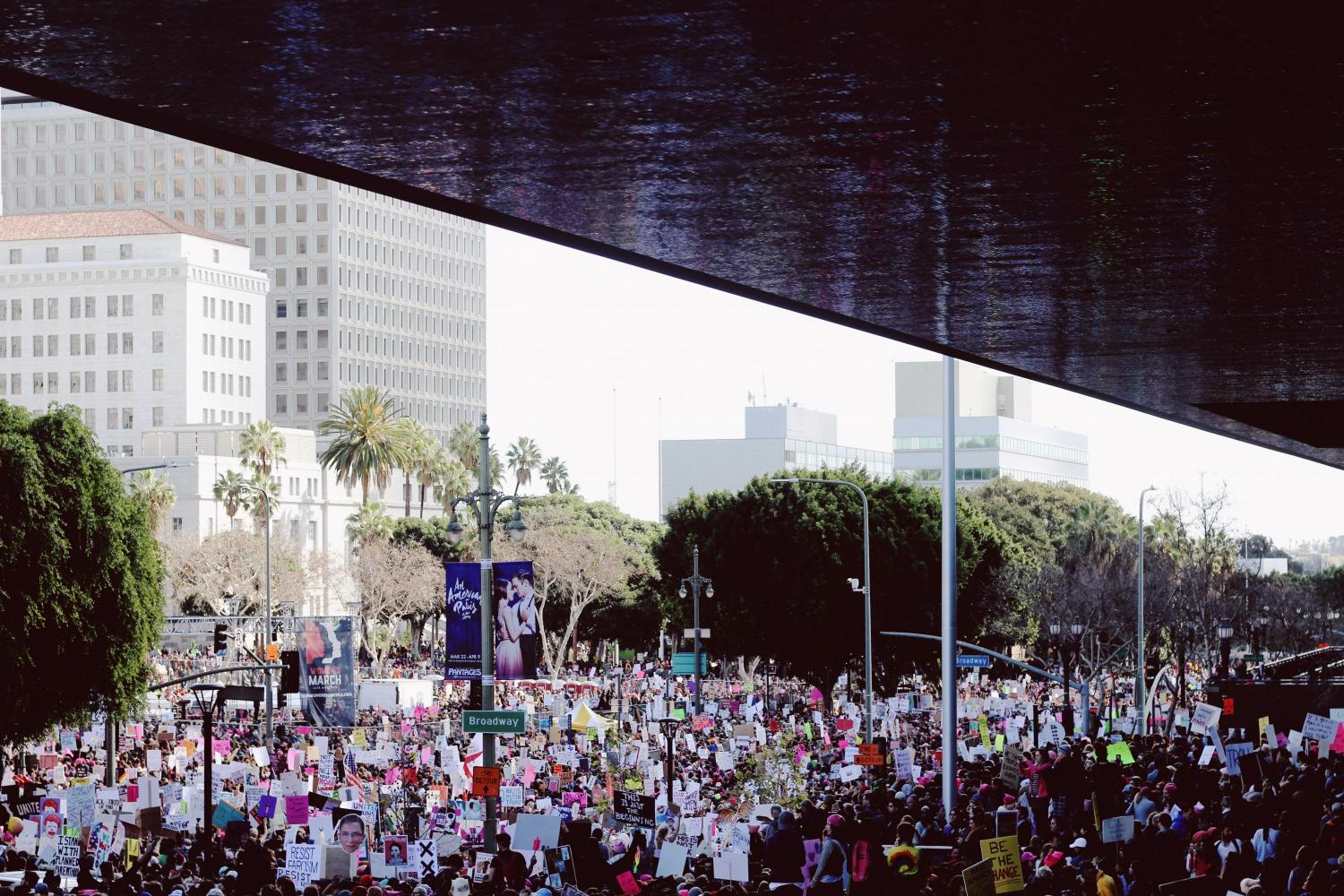
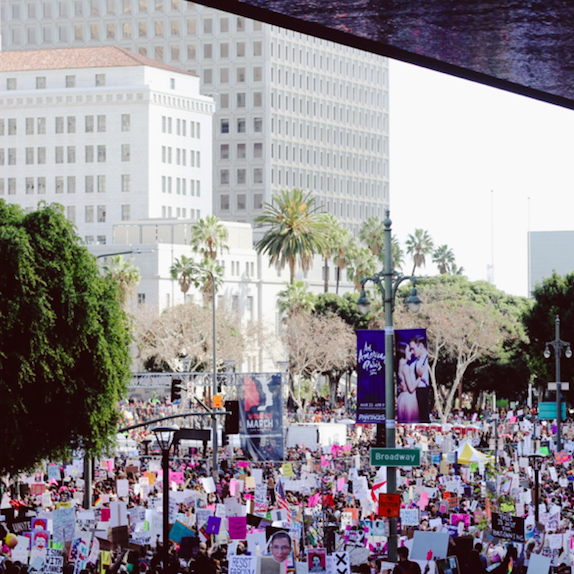
On May 21, a group of seven women-led and -oriented companies placed an open letter in The New York Times, in which they spoke out against new and proposed state legislation bans on abortion. Barely three weeks later, the corporate anti-ban movement has snowballed into a second public letter in the Times. This one, titled “Don’t Ban Equality,” was supported by more than 180 companies. The group is dominated by brands associated with female consumers, but many other companies, large and small, have also signed on.
Why the New York Times abortion statement is just the beginning
Not too long ago, the topic of abortion rights was something that U.S. business leaders almost uniformly avoided. Now, the topic has launched what has become yet another example of next-level corporate activism. From gun control to immigration rights, companies are stepping into the media spotlight on matters of broad social concern.
Recent events marking the gun safety movement illustrates that point. For decades, the National Rifle Organization (NRA) and its political allies have dominated the national conversation on gun control. Only a very few high-profile business leaders dared to speak publicly in favor of what they insisted are common-sense gun safety regulations.
Now the situation has reversed. The NRA is foundering and the gun control movement is gaining momentum at the ballot box, with the public support of a fair share of leading U.S. businesses.
Gender equality, gender diversity and abortion rights
The abortion rights movement has crossed over into the business community in a similar way.
The decision to go public on a controversial issue is never an easy one, especially when the public debate splits along party lines and across society.
That makes the new public letter is all the more noteworthy. The letter was organized by three groups strongly associated with liberal and progressive activism and political support for the Democratic Party: Planned Parenthood, the American Civil Liberties Union, and the National Abortion Rights Action League (NARAL).
Nevertheless, the letter was made almost inevitable by this shift within the corporate social responsibility movement. The three groups make this change clear throughout the letter and supporting materials, including a press release and website.
The key passage in the public letter is this:
“Equality in the workplace is one of the most important business issues of our time."
"When everyone is empowered to succeed, our companies, our communities and our economy are better for it.”
The letter emphasizes that restrictions on abortion and other health care for women “threatens the health, independence and economic stability of our employees and customers. Simply put, it goes against our values and is bad for business.”
The website and press release also both state that “business leaders are stepping up to say that these bans go against their company values and negatively affect efforts to promote equality in the workplace, putting businesses, communities and the economy at risk.”
Corporate activism and the bottom line
Crucially, the public letter draws a sharp, tight line between abortion rights and the bottom line. It concludes:
“Simply put, [restricting reproductive care] goes against our values and is bad for business. It impairs our ability to build diverse and inclusive workforce pipelines, recruit top talent across the states, and protect the well-being of all the people who keep our businesses thriving day in and out.”
If you caught that line about top talent, that is perhaps the most significant aspect of this latest public letter.
The global business community is in a race to attract the best possible talent and the next generation of innovators.
Companies that diversify — on sexual identity as well as gender and race — are realizing new benefits through inclusive policies, proactive outreach and employee training.
Those companies that fail to diversify their workforces are facing a troubled future, partly by failing to identify problematic areas in their operations, and more directly by failing to expand their recruiting efforts.
In the U.S., the talent issue has come into stark relief as the workforce diversifies with more women and non-whites in top fields, along with more people who identify outside of the conventional borders of gender.
The private sector-government connection
The latest wave of abortion restrictions also has an impact on U.S. companies that conduct business with government agencies like the Department of Defense and the Department of Energy. Together, these agencies employ thousands of highly-skilled workers in facilities that sprawl across the U.S. - including career-oriented women in the workforce who are in their childbirth years all through peak periods for academic progress, on-the-job training and promotion.
So far few of the very largest corporations have joined in the #DontBanEquality effort, but the trickle could soon turn into a flood.